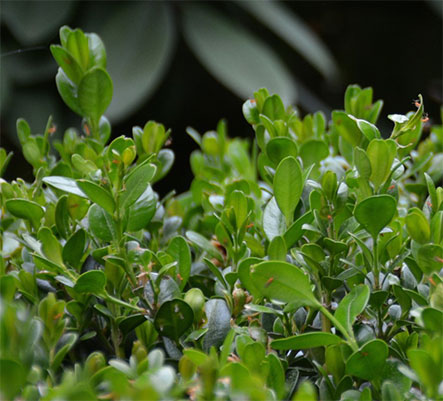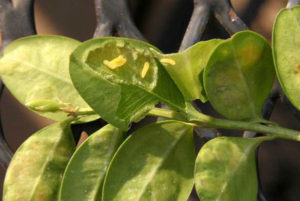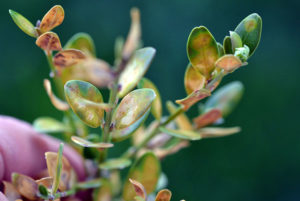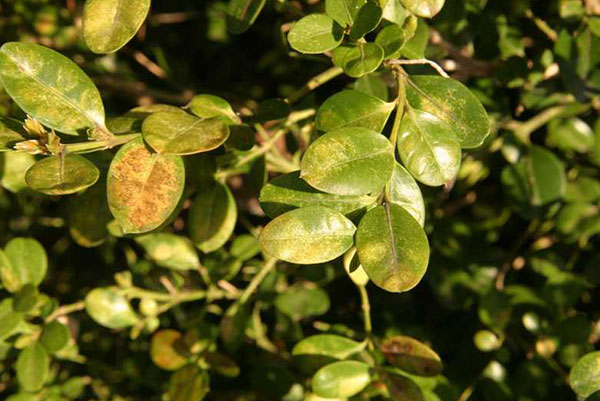Boxwood Leafminer: Identification and Treatment
The boxwood shrub is a common sight on many Midwestern lawns. The boxwood is a preferred choice and popular addition to both residential and commercial landscaping efforts. They are prized for their evergreen foliage that provides year-round color, and their ability to thrive in any amount of sunlight from full sun to partial shade.
Unfortunately, like other less resilient shrubs, a boxwood is just as susceptible to insect pests, the most damaging of which is the boxwood leafminer. Technically a midge, these small insects feed on the tissue inside of boxwood leaves causing discoloration, raise blister-like bumps, and can even kill a boxwood if the infestation is severe. Despite the danger these insects pose to Boxwood shrubs, there are several ways to prevent or treat leafminer infestations.
What Is a Boxwood Leafminer?
Boxwood leafminers are thought to have arrived at the same time that the boxwood was introduced to North America in the mid-1600s as potted plants, but the boxwood leafminer wasn’t considered to be a real problem for the boxwood until the early 1900s. Now they live coast to coast in North America, and devastate boxwood shrubs, their only source of food.

The adult boxwood leafminers emerge from the inside of the leaf over a period of 10 to 14 days in late spring, depending upon the weather. Each leafminer only lives for around 24 hours during which time they mate. The female lays about 30 eggs which she then inserts into the underside of the new growth of boxwood leaves.
The eggs hatch anywhere from 14 to 21 days later in early summer and the larvae feed on the inside tissue of the leaves all summer and winter. There can be 10 or even more larvae present in a single leaf, causing the blister-like bumps to form. The larvae continue to live inside the leaves and feed for nine to ten months until they pupate in spring and emerge as adults to continue the cycle.
The good news about boxwood leafminers is that there is only one hatching and growth cycle per year. This makes it easier to identify and manage infestations.
Identifying a Leafminer

The adults grow to be roughly the same length and resemble a small mosquito with orange and tan coloring. The adults are weak fliers and typically hover close to the boxwood plant to mate and lay eggs. You can shake the shrub and look for these gnat-like flies when they are in their adult form.
What Happens to a Boxwood with Leafminers?

- Discoloration of leaves, making them appear yellowish or brown
- Smaller sized leaves
- A crinkled and disfigured appearance to the leaves
- Defoliation of a branch or the entire shrub
- Irregularly shaped blotches on the leaves surface
- Raised blisters that indicate the presence of larvae within the leaf and grow more prominent during the late winter and early spring
- Snakelike patterns that indicate tunneling, or mining, of the larvae as they move within the leaf to feed
- Heavy infestations can create a crackling sound near the boxwood
Damage from boxwood leafminers is not reversible. You must treat the affected areas and take action to prevent further population growth as soon as you see signs of their presence. A light infestation can generally be resolved with natural or chemical means, and will cause little damage to a boxwood plant. A severe infestation that goes unaddressed could kill a boxwood shrub in as little as a year.
Preventing Leafminers

The introduction of some new cultivars that were highly susceptible to leafminers has brought greater awareness to this issue. There is a wide range of cultivars that are categorized by their ability to withstand pests and are graded in varying degrees from potential damage to complete destruction.
For the best cultivars for new plantings known to be resistant to boxwood leafminers, choose from the following:
- Buddy
- Franklin’s Gem
- Golden Dream
- Green Pillow
- Nana
- Morris Dwarf
- Winter Gem
Try to avoid these cultivars:
- Chicagoland Green
- Green Gem
- Green Velvet
- Justin Brouwers
If you select any of these or currently have these plants, you must be vigilant and take proactive measures to keep your boxwood shrub healthy. Conduct a regular inspection and take the necessary actions to eradicate the presence of boxwood leafminers as soon you find them.
Boxwood Leafminer Treatment
Once you detect the presence of leafminers, whether in the larval adult stage, you can choose from several boxwood leafminer treatment options available to you. The choice between chemical and natural treatments depends upon the severity of the infestation, your location, and your personal preferences. For instance, if you have small children or pets, you may opt to use non-chemical treatment options where possible to prevent them from coming into contact with the pesticides.
Chemical Treatment Options
Always test for the presence of boxwood leafminers before applying any type of chemical to your shrubs. Do this by dissecting a leaf or holding it up to the light to locate larvae. Some common signs of damage can be attributed to other pests or even diseases. You should only use chemicals when necessary.
Chemical treatments are very effective when done correctly. They have great results even for moderate to severe infestations. It is best to target the treatment at the larvae since the adults live for such a short period. Their emergence is dependent upon the weather and you may miss your opportunity to treat infestations if you don’t catch the infestation in time.
Use systemic insecticides sprayed on the larvae when they first hatch, and continue treatments through late summer for best results. Imidacloprid is effective at controlling leafminer populations, but it may adversely affect the honeybee population.
Another tactic for chemical treatment is soil injection. This is a good choice if you can detect visible signs of boxwood leafminers in the foliage of your shrubs. Systemic soil injection is typically done in the spring and provides protection for a year. You must have the treatment done annually to keep your boxwood safe.
Keep in mind that the right cultivars are naturally resistant to boxwood leafminers, eliminating the need for you to spray chemicals. If you prefer to avoid pesticides or are unable to use them for any reason, it is worth looking into these varieties.
Natural Treatment Options
There are also several natural treatment options available if you prefer to avoid the use of chemicals. These are best done as preventative measures or when infestations are less serious.
Pruning is a simple and effective way to eliminate boxwood leafminers. You can prune away the infested foliage and dispose of the clippings. Be careful to cut away the entire affected area while leaving enough growth for the plant to remain strong and regrow. This method is feasible only if you require light pruning. Heavy infestations that necessitate cutting away large portions of your boxwood could cause greater damage to the shrub as a whole.
Another method is to introduce some natural predators of the boxwood leafminer, such as green lacewings and certain spiders. These species can control the infestation for you without doing any damage to your boxwood shrubs.
You can also pinch blisters or discoloration that indicates the presence of larvae. If you pinch hard enough to kill the larvae.
Finally, another good recommendation is to keep your plants healthy by planting them as directed and provide them with the right amounts of water and food. Healthy plants are more capable of resisting infestation and damage from pests.
Protect your boxwood plant from leafminer damage. Inspect leaves for signs of blisters and mining, as well as discoloration. Take action at the first sign of an infestation. The earlier you identify the presence of leafminers, the easier it should be to eliminate them. With a little extra vigilance and effort, you can keep your boxwood shrubs healthy so they remain a gorgeous part of your landscaping.
Do You Need Professional Boxwood Leafminer Treatment?
Are leafminers destroying your boxwood shrubs? At Ryan Lawn & Tree we offer professional insect & disease control to treat and protect your boxwood.
We would love to help you. Get a Free Estimate today for help with your boxwood leafminer treatment needs by a RYAN tree and shrub care expert!









